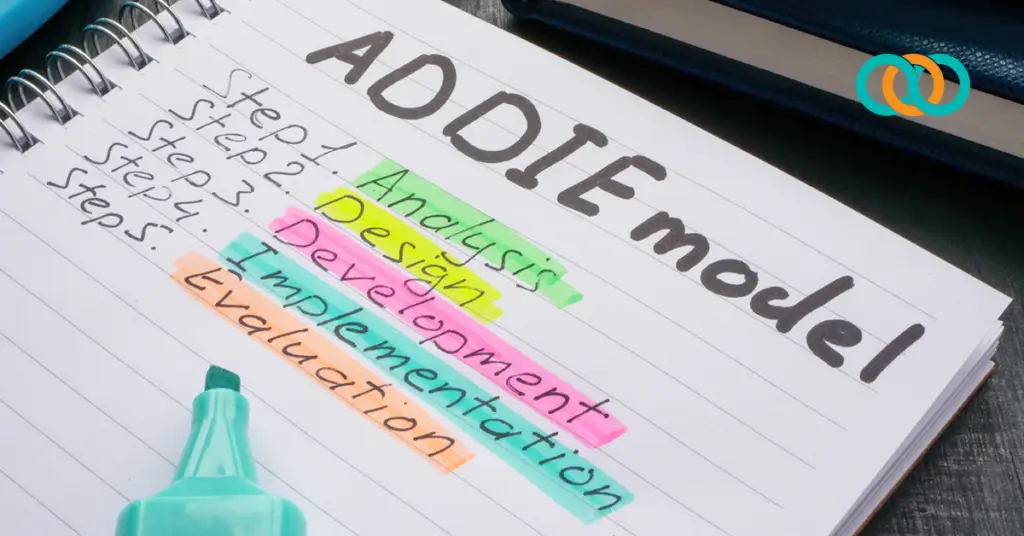So, you’re curious about instructional design? Maybe you’ve heard the term tossed around in a conversation or seen a job listing for an instructional design contractor and wondered, “What is that exactly?”
Welcome to the world of learning design! Whether you’re a teacher looking to pivot careers, a corporate trainer who wants to level up, or just someone who loves learning and helping others do the same—this article is for you.
One of the first things you’ll hear about in this field is something called ADDIE. It’s a framework—kind of like a roadmap—for creating training and learning experiences. Think of it as the Instructional Designer’s trusty GPS.
Let’s break it down and explore how this model forms the foundation of great instructional design work.
What Is ADDIE?
ADDIE stands for:
- Analysis
- Design
- Development
- Implementation
- Evaluation
It’s a framework that helps instructional design professionals and consultants create effective learning programs—whether that’s an online module, a virtual instructor-led class, or even a full-blown corporate onboarding experience.
You’ll find that many instructional design consultants still use ADDIE (in full or in part) today because it offers structure without boxing you in creatively.
Phase 1: Analysis
This is where everything starts. In the Analysis phase, instructional designers ask questions like:
- Who are the learners?
- What do they need to know or do?
- Why is this training even needed?
- What’s the gap between current and desired performance?
- What is the desired future state?
You’re basically putting on your detective hat. A solid analysis helps avoid the classic mistake of creating training just because someone said, “We need training on this.”
In the real world, instructional design contractors might do this step by conducting interviews with stakeholders, reviewing performance data, or analyzing survey results.
Pro Tip: This phase can uncover that training isn’t actually the solution—which is a good thing to find out early!
Download Your Copy of a Sample Needs Analysis Report
Phase 2: Design
Here’s where the creative planning starts. You map out the learning objectives, decide on the structure, and choose the best strategies to help people learn.
This is also when you:
- Write learning objectives using models like Bloom’s Taxonomy.
- Choose delivery methods (eLearning? Instructor-led? Blended?)
- Draft outlines, storyboards, and scripts.
- Plan assessments and activities.
If you’re the type who loves organization and structure and enjoys being creative—this phase might be your sweet spot.
Designing a learning experience is like designing a building. You’re not building it yet, but you’re drawing up blueprints and picking out the tools you’ll need.
Phase 3: Development
Now it’s time to bring the plan to life. In the Development phase, instructional designers (or the eLearning developers they work with) build out the actual materials.
That could include:
- eLearning courses built in tools like Articulate Storyline or Rise
- Slide decks for classroom delivery.
- Instructor guides, participant handouts, or job aids.
- Videos, animations, and simulations.
As a new instructional designer, you may be responsible for both the design and development work, especially on smaller projects. On bigger teams, these tasks might be split between multiple specialists.
Tip: If you’re planning to freelance, developing a strong portfolio of these deliverables will help you stand out.
Phase 4: Implementation
This is “go-time”. The program, course, or training you designed is rolled out to learners. Implementation can be as simple as uploading an online course to a Learning Management System (LMS) or as complex as coordinating a company-wide rollout across multiple time zones.
In this phase, instructional designers often:
- Conduct train-the-trainer sessions.
- Work with IT or LMS administrators to launch courses.
- Support pilot runs and gather real-time feedback.
Instructional design consultants are often brought in to help organizations manage this phase smoothly, especially when the stakes are high—like compliance training or onboarding programs.
Phase 5: Evaluation
This is where you figure out if the training actually worked. Did it move the needle on the goals you uncovered during the Analysis phase? Did people learn something useful—and are they applying it on the job?
Evaluation is often broken into two parts:
- Formative Evaluation: This happens throughout the design and development process. It includes things like stakeholder and SME reviews, alpha and beta testing, and pilot feedback. The goal here is to catch issues early and make improvements before full launch.
- Summative Evaluation: This takes place after training is delivered. It focuses on learner feedback, assessments, business outcomes, and performance metrics. It’s about determining overall effectiveness.
Many instructional designers use Kirkpatrick’s Four Levels of Evaluation as a framework:
- Reaction – How did learners feel about the training? (Usually measured with surveys.)
- Learning – Did they acquire the intended knowledge or skills?
- Behavior – Are they applying what they learned on the job?
- Results – Did the training impact broader business goals like productivity, quality, or revenue?
Some organizations also layer in the Phillips ROI Model, which adds a fifth level: 5. Return on Investment (ROI) – Was the financial return on the training greater than the cost to develop and deliver it?
How L&D Teams Use Evaluation Data
The data gathered through evaluation isn’t just a “nice to have”—it’s incredibly valuable. Here’s how learning and development departments use it:
- Demonstrate the value of training to leadership and stakeholders.
- Improve future iterations of the course or program.
- Identify knowledge or performance gaps that still exist.
- Make data-driven decisions about which programs to expand or retire.
- Tie learning outcomes to business metrics (like fewer errors, better sales, or faster onboarding).
- Prioritize resources and budget for high-impact learning initiatives.
- Coach facilitators and trainers on improving delivery.
- Fine-tune assessments and activities to better measure or reinforce learning.
- Build credibility within the organization by showing the impact of L&D efforts.
- Support compliance and audit requirements, especially for regulated industries.
Evaluation isn’t just the end of the ADDIE process—it’s what closes the loop and proves the work was worth it. And for instructional design consultants or contractors, having a strong evaluation plan is key to showing ROI and making a case for ongoing investment in learning.
Why ADDIE Still Matters
Some people say ADDIE is “old-school,” but it’s still widely used—and for good reason. It gives structure to what can otherwise feel like a chaotic process, especially for new instructional designers just starting out.
Plus, it’s flexible. You don’t have to follow it in a strict, linear way. Many instructional design professionals use a more agile or iterative version of ADDIE, looping back as needed.
Think of ADDIE like a recipe. Once you’ve mastered it, you can add your own flair.
How Instructional Design Consultants Use ADDIE
Whether you’re working full-time at a company or doing freelance work as an instructional design consultant, ADDIE is part of the job. You’ll use it to:
- Communicate clearly with clients and stakeholders
- Plan realistic timelines and deliverables
- Explain your design choices with confidence
- Align your work with business goals
If you’re thinking about becoming an instructional design contractor, mastering ADDIE will help you land gigs, earn trust, and produce solid work—even when project scopes are fuzzy or timelines are tight.
Getting Started in the Field
If this all sounds exciting and you’re ready to explore a career in instructional design, here are a few tips to kick things off:
- Learn the Tools: Tools like Articulate Storyline, Rise, Camtasia, and Vyond are common in this field. The good news? Many offer free trials and tutorials.
- Build a Portfolio: Even if you’re just getting started, create sample projects based on what you’re learning.
- Network with Others: LinkedIn groups, online communities, and in-person meetings like ATD chapters can be great places to meet others in the field. Don’t forget to register with and interact with TrainingPros!
- Follow Industry Trends: Check out sites like Training Industry or eLearning Industry for articles and resources.
- Keep Practicing: Like any profession, you get better with practice. Start small, keep learning, and build from there.
Wrapping It Up
ADDIE is the backbone of instructional design, and understanding it will give you a major leg up whether you’re applying for your first job or launching your career as an instructional design consultant.
It’s not just theory—it’s a practical, real-world framework that helps you stay focused, solve problems, and create learning that sticks.
Download Your Copy of 5 Tips for a Knockout Consultant Resume
Ready to Work with Us?
Does your L&D team have more projects than people? TrainingPros has been named a Top 20 Staffing Company internationally by Training Industry, and recognized as a Smartchoice® Preferred Provider by Brandon Hall Group for 2025. We’re also proud to be named a Champion of Learning by the Association for Talent Development (ATD)—an international honor that reflects our dedication to excellence in corporate learning. These accolades underscore TrainingPros’ unwavering commitment to delivering high-quality, tailored training solutions.
If your projects need instructional design consultants, eLearning developers, or other L&D consultants for your custom content projects, reach out to one of our industry-expert relationship managers today.
When you have more projects than people™, let TrainingPros find the right consultant to start your project with confidence. Schedule a consultation today.
- 2shares
- LinkedIn0
- Twitter0
- Facebook0
- Love This2











